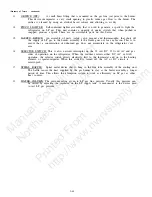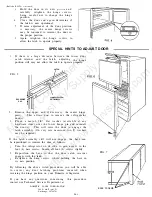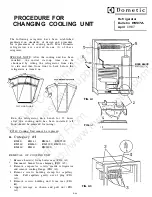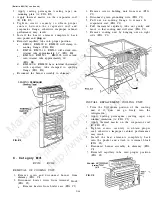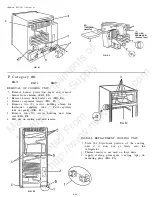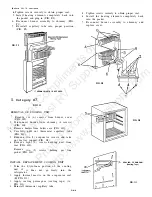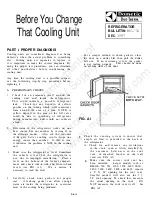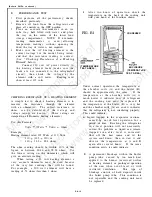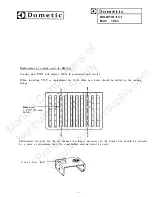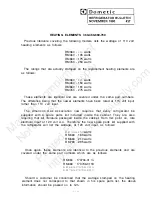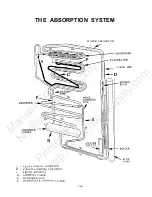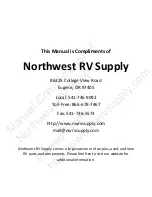
(Bulletin R61/7A continued)
NOTE: The cooling units currently being used
are specially designed to prevent overheating of
the boiler tube even when operated out-of-level.
This special design can be identified by the
round insulation box around the boiler, rather
than the square-cornered box used on older units.
FIG. B2
Older Style Current Style
Boiler Enclosure Boiler Enclosure
Blockage symptoms on the newer cooling units
almost always, indicate trapped liquid in the
evaporator, which can be corrected by proper
leveling and allowing the cooling unit to cool
off before restarting.
6. If the temperatures are satisfactory in Step
5, continue operating the unit, with power
directly to the heating element, for a total
of 10-12 h o u r s . The doors must be kept
closed for this entire period.
7. If the temperature is within the previously
mentioned guidelines the problem is not in
the cooling unit. See Section
II. OTHER
C A U S E S
for additional items that could be
causing a loss of cooling.
8.
If the temperature in the food compartment
is higher than the acceptable limit, the
cooling unit is probably defective. If you
are still in question as to the performance
of the cooling unit, please contact our Techni-
cal Service Department (219) 463-4858. See
the next paragraph before changing the
cooling unit.
9. The importance of adequate air flow across
the cooling unit cannot be emphasized too
much. A minor restriction in the venting
system will not create a problem on cooler
days - the available air flow will still provide
adequate cooling due to the lower temperature.
However, on a hot day (90” or more) even
a minor restriction will cause overheating of
the cooling unit and the cooling process will
slow down or stop.
ONE LASTCHECK
If the previously mentioned test was performed
in air temperatures above
and the
temperature in the refrigerator is above the
acceptable ranges, it may indicate a restricted
air flow. To make sure there is no problem
with the venting system repeat the perfor-
mance test with the refrigerator removed
from its installed location and placed on
the floor, or in your service shop. If the
second test indicates satisfactory performance,
re-check the venting and installation.
PART II. OTHER CAUSES FOR
LOSS OF COOLING
If the previously mentioned performance test
shows that the refrigerator is working satisfac-
torily, and the customer still experiences loss of
cooling, the following items need to be considered:
1. Make sure the customer is using the refriger-
ator properly. The cooling capacity of the
absorption refrigerator is usually much lower
than the refrigerator the customer has in his
home, so the customer should be advised to
follow the instructions for proper use in his
Owner’s Manual.
A.
B.
C.
D.
Start the refrigerator the day before it
is to be filled with food.
When the refrigerator is being filled
when preparing for a trip, the food
should be pre-cooled, and frozen foods
should be pre-frozen, before placing
them in the refrigerator. Ice making
should be avoided until the refrigerator
has cooled the lower compartment to the
desired temperature.
Air circulation within the food compart-
ment is important for proper cooling.
DO NOT place paper on the shelves or
over-fill the compartment with large
cartons, etc.
Do not put hot food in the refrigerator.
Allow it to cool in room air first.
D-9-13
Manual
Compliments
of
Northwest
RV
Supply
Printed
From
http://www.nwrvsupply.com


